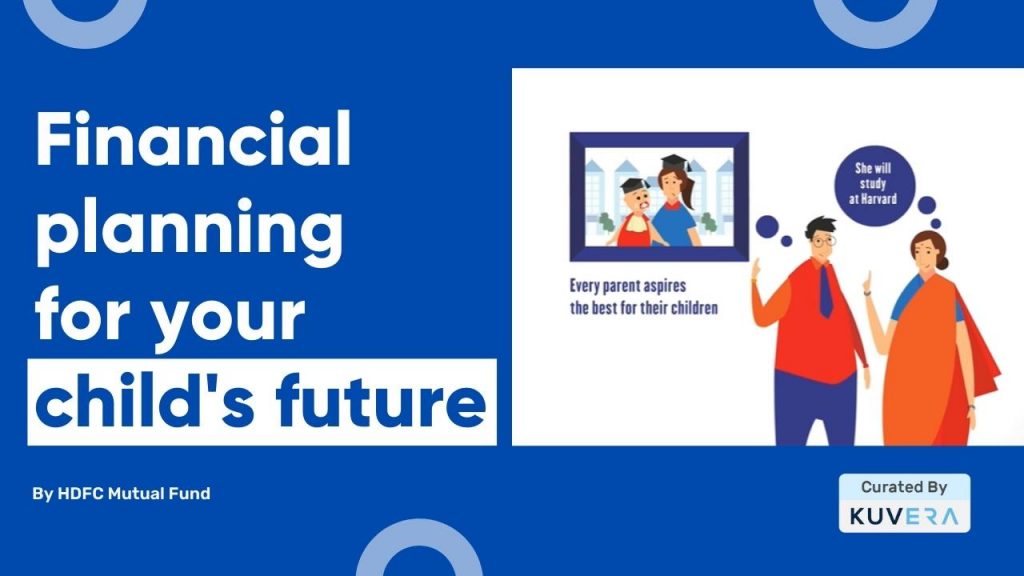Why saving is not enough if you want to secure your child’s future?
It’s every parent’s dream to provide the best for their children. Many of you might have saved a substantial amount of money to realize that future. But is it enough for your children until they are independent?
In traditional savings instruments like bank deposits and endowment policies, the average interest rate is around 5-6%. Furthermore, the interest on bank deposits is fully taxable per the investor’s income tax slab, which means that the post-tax and inflation-adjusted returns on such instruments are almost negligible.
As inflation increases and interest rates on traditional investments remain low, it’s more important than ever to plan wisely for your child’s future needs. One way to do this is by investing in mutual funds, which can help you select the right combination of assets to invest in. A diversified portfolio of mutual funds also has the potential to generate long-term returns that exceed inflation.
What’s the rate of inflation in the education sector?
As you know, education plays a vital role in your child’s success in the future. Schools and colleges charge very high fees today to impart any knowledge. Furthermore, ancillary expenses like tuition, stationery, uniforms, extracurricular activities, etc., have increased significantly. Hence spending on children’s higher education requires prudent planning.
The current level of inflation in education is around 8-10%, so you should not neglect this when planning for your child’s higher education.
Suppose a postgraduate program abroad costs Rs. 25 lakh right now, and your child will likely attend it in five years — assuming 8% annual inflation, the fees will be Rs. 36.73 lakh at that point in time.
How can mutual funds secure your child’s education?
-
Beats Inflation
Increasing inflation and competition make it increasingly crucial to invest in options such as mutual funds, which have the potential to beat inflation. Upon finishing their education, your child will begin their career or pursue a profession. When they become independent, you may want them to settle down and marry. Again, prudent planning is required to make this dream a reality.
Many Indian parents feel that it is their responsibility to spend on their children’s weddings. Typical Indian weddings cost anywhere from Rs 8-25 lakhs. While parents don’t mind how much they spend on their children, it’s essential to fulfill this goal without getting yourself into debt traps.
-
Helps you start early
Starting early is always a good idea when planning for your child’s needs. Due to compounding, if you start saving and investing early, you can accumulate higher funds by the end of your financial goal. (for example, your child’s education). To achieve your financial plan, you will need to contribute a higher amount to your monthly investment if you delay your investment.
A majority of mutual funds are long term investment plans with lock-in periods. This help you inculcate financial discipline.
-
Professionally managed
Mutual funds not only beat inflation due to diversified schemes but also are managed professionally by qualified and certified experts who know how to allocate assets in the right proportions depending on your risk tolerance.
Types of mutual funds
It’s vital to optimize your mutual fund portfolio across equity mutual funds, debt mutual funds, and gold funds taking into consideration age, income, expenses, assets, liabilities, risk appetite, and time horizon to financial goals. Let’s understand this better:
-
Equity-oriented mutual funds
Investing in equity-oriented mutual funds can be a great way to grow your portfolio. There are many different types of these funds available, each with its distinct characteristics and investment mandates:
- Large-cap funds.
- Large & midcap funds.
- Mid-cap funds.
- Small-cap funds.
- Multi-cap/flexi-cap funds.
- Value style funds.
- Focused funds.
- Thematic/sector funds.
Researching and outlining your goals will help you find the right fund to accumulate the necessary funds. After assessing several quantitative and qualitative parameters, choose the most suitable schemes. Only invest in equity mutual funds if your time horizon is at least 3-5 years and you can afford to take moderate to high risks.
If you’re trying to decide whether to invest in a lump sum or through a systematic investment plan (SIP), it’s generally best to go with the latter. SIPs make timing the market irrelevant, reduce the impact of market volatility, and leverage the benefits compounding to help you achieve your financial goals.
-
Debt mutual funds
Mutual funds such as Banking and PSU Debt Funds, Gilt Funds, Liquid Funds, Overnight Funds, and fixed-income instruments like Bank Fixed Deposits can help you lower your risks and stabilize your portfolio.
Consider shifting your allocation from equity mutual funds to debt mutual funds and fixed-income instruments when you are close to achieving your financial goal, and your risk-taking capacity is medium-to-low.
-
Gold
One of the most valuable assets in a recession, gold acts as a haven, a hedge against inflation, and a store of value during times of economic uncertainty. Additionally, gold is an excellent way to diversify your portfolio.
As you allocate your assets, make sure gold is a part of it. You should allocate up to 10-15% of your total investment portfolio to gold. If you want to invest in gold ‘the smart way,’ do so through gold ETFs (Exchange Traded Funds), gold savings funds, or sovereign gold bonds instead of buying physical gold.
What are Children’s Funds?
According to SEBI, Children’s Funds are equity-oriented mutual funds locked in for five years or until your child attains a particular age. Due to the lock-in, you must carefully assess your liquidity needs to achieve your goal. If the solution-oriented scheme underperforms during the lock-in period, you will not be able to switch to another worthy scheme.
Top Rules to Keep Your Child’s Future Secure
- Maintain a regular review of your portfolio (at least once a year) and make necessary changes/adjustments as needed.
- Ensure that you name your child as a nominee for all the investments you plan for their future. When the family’s breadwinner dies, gets sick, or becomes disabled, this can be a significant setback for the child’s future. Hence, your family must be adequately insured.
- It is good to set aside 12-24 months’ worth of regular monthly expenses, including loans or EMIs into a separate savings account. This will help you deal with unexpected crises, such as medical emergencies, sudden increases in school fees, job losses, etc.
Final Words:
Don’t delay and invest in mutual funds right now if you wish to provide the best education for your child that’s well within your means.
Interested in how we think about the markets?
Read more: Zen And The Art Of Investing
Check out all our “Investor Education Originals” videos on Youtube and get smart about investing.
Start investing through a platform that brings goal planning and investing to your fingertips. Visit Kuvera.in to discover Direct Plans and Fixed Deposits and start investing today.
#MutualFundSahiHai #KuveraSabs

